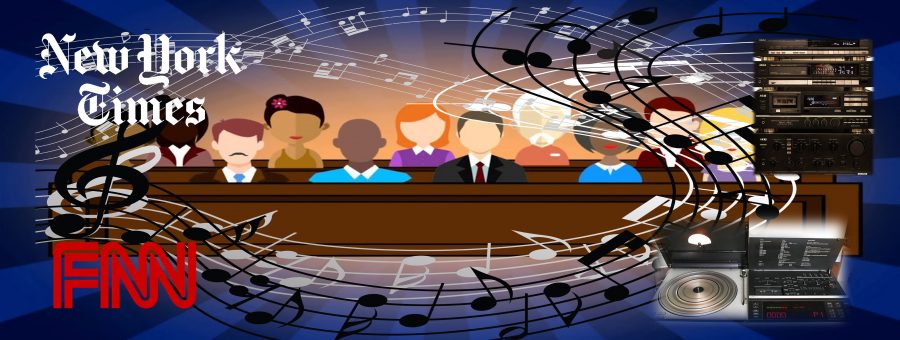Why Diversifying in News is Like Being a Hi-Fi Aficionado

Shôn Ellerton, January 26, 2021
Be the jury of what you hear and read. My analogy of being heavily diversified across many news sources to that of being a hi-fi aficionado.
I like music. Love listening to it, especially when sat down in my living room being thoroughly immersed as if listening to the performers live on stage. This, of course, needs a good stereo or hi-fi system and needs to be set at a volume roughly as it should be if one was there near the stage. Through the years, I have enjoyed exploring music away from the mainstream, and engaging with others who do as well. Yes, I like Pink Floyd, Led Zeppelin and Vivaldi’s The Four Seasons, but if someone shares their music collection with me and every artist or piece of music in that collection is known to me or, to hundreds of other millions of people in the world, it is not going to be likely that I will gain further enlightenment in the world of music.
I also like to keep up with the latest news and current affairs ranging from politics and social issues to technology and the environment. Many would agree with me is that to be more effectively informed is to scour from a wide variety of news sources, rather than relying on one or two sources. Engaging with others who, likewise, consume their news from many other sources are far more interesting to hold a conversation or partake in a rigorous debate than from those who limit themselves to the mainstream few. Yes, I read the BBC, the ABC and other mainstream media from time-to-time, but am I going to get the nuances and insights by reading these alone? Of course not.
Why am I mixing the subject of listening to music and engaging in reading the news and holding a rigorous debate in the same piece? Allow me to explain by way of a comparing how we listen to music and how we take in the news.
At a quite young age, I became obsessed with amassing a reasonably-sized collection of records and CDs. However, I was also obsessed with not only the content of the music but the quality of the recording. For me, it’s a little bit of a tragedy when a great piece of music is created only to be then recorded poorly. As for older works, where access to high-quality studios was more difficult and expensive, this was, likewise a shame but unavoidably so. For very old recordings, usually of performers of classical music, the recording technology was just not available. Seldom can I enjoy a piece of music; however magnificent, if the recording is poor.
I began to build up a hi-fi system as a student, and as a student with a small budget, one starts off small and gradually builds on it during successive years. To do this, involved a great degree of research and patience. Finding the right match by listening to it before buying. If it was unaffordable, the great hunt for scouring the second-hand market was a necessity. I was to become one of those strange people. The hi-fi aficionados who carefully mixed and matched bits of hi-fi, often from different manufacturers, to get the system they want to sound like. These systems comprised of what is known as ‘separates’.
Most of us are ‘normies’ and not hi-fi aficionados. Those who are not can be divided into three camps.
Let us start with those in the first camp.
The first are of those who buy the all-in-one system, being first made very popular in the 80s and early 90s, known strangely as ‘midi’ systems. Remember those all-in-one matching box affairs complete with CD, tuner, cassette deck, and amplifier with a cheap and cruddy turntable designed specifically to maul your records? Those in this camp represents the masses who thrive on the convenience to shop all from one source. These all-in-one systems are often appealing visually, or, at least, some are, with respect to being neat and tidy. They come straight out of a box along with a massive shell of polystyrene impossibly big to fit in any bin without resorting to violence by snapping them apart across one’s knees. And no horrible bits of wire and cable—the wife’s nightmare–twisting all over the room, a constant issue with ‘separates’ systems. They were often reasonably well-priced in those days. However, if any part failed, generally, the whole unit had to be returned. Alluding to my comment above about being the wife’s nightmare without being sexist, I apologise to the very few women out there who are into hi-fi!
The typical characteristic of one who buys one of these all-in-one systems is one who generally trusts a large well-respected and popular brand to put together a system that will work for them. They might have tried it out in an, already, loud environment like a typical high-street shop, but in many cases, they will read a quick review, look for the four stars or whatever the ratings are, and push the ‘buy’ button. Typical manufacturers who create such items are well-known, popular and respected. For example, Sony, Yamaha, Panasonic are manufacturers many would have heard of. Unfortunately, this camp represents the great majority, and sadly, those who are not aware of what they are missing out by doing a little extra work to get a good ‘separates’ system. Having once worked with a hi-fi dealer in London, I converted practically anyone who had listened to an all-in-one system to a separates system through demonstration at matching price points. In almost all cases, the response was of genuine surprise how something could sound that amazing. Moreover, the bonus that many separates items can last for much longer, some for life, was a total revelation to my new converts.
In this first camp comprising of the great masses, we could make a reasonable analogy that the purchase of the all-in-one system from a well-known manufacturer is not unlike that of subscribing to one or two well-known mainstream news networks. For example, the ABC in Australia, the BBC in the United Kingdom, CNN and Fox in the United States and Pravda in Russia. The convenience factor is at play having only the need subscribe to their web services and download their exclusive apps. The quest for variety or for more nuanced insight and alternative angles is not really of prime significance. It is consistency of format, familiarity of the journalists and the convenience of access that is of importance. Quality, bias and veracity of news sources vary enormously on both sides of the equation, but if one is exposed to one or two consistently biased news sources, exposure to further insight, nuance and context is hindered enormously. Laziness and suspicion are often attributes held by many in this camp. For example, the lack of willingness for one so used to reading one or two favourite news sources to read another a story from another news source as recommended by a friend or acquaintance. Rather than read the alternative news source, laziness and suspicion kicks in, sparking off that most irritating of responses. To reply with a link by another news source that either that information is allegedly false, with the aid of a ‘fact-checker’, or that it is politically biased without reading the article in question.
“We could make a reasonable analogy that the purchase of the all-in-one system from a well-known manufacturer is not unlike that of subscribing to one or two well-known mainstream news networks.”
Let is move on to the second camp.
Those in the second camp buy portable systems, often complete with electronics to network into one’s Spotify account or those comprising of large ‘boom boxes’ so characteristic of the 80s. There are those who buy them out of necessity, for example, tradies, construction workers, those going out for picnics or wherever portability is required. However, I refer to those who buy it for the sake of being the smallest possibly device to adorn the living room. Sound quality is incidental and not important. Just the ability to recognise the tune of a song, or at least, enough to hum to it, or just to use as a simple radio with practically no footprint in terms of space in the house. The fact that they are so small, of course, physically limits the ability to create any sense of space or gravitas. Much of what we hear today, particularly that of mainstream music, is dynamically compressed, making it more listenable on systems limited in size, including most standard audio systems built into cars. Nuance, detail, dynamics and other textures of the music are flattened and sometimes nearly obscured altogether. This could account for one of the reasons why complex music with greatly varying dynamics is simply not terribly popular with the masses because many have simply not been able to enjoy it over poor equipment or in a poor environment. This is quite understandable.
In the world of news and current affairs, those in the second camp are those who get all the news from social media posts, tweets, soundbites and memes. Like the portable player, boom box and car radio, with the exception of headphones, nuance, context and detail is veiled to such an extent, that the news or piece of music is often unquestionably distorted far off from its original intent. For example, take Holst’s contemplative and slightly-sinister classical piece, Saturn. Apart from a very loud climax, most of the piece is beautifully subtle with many layers of intrigue and mystery, most of which will never be heard through a poor audio system. This is partly because, should one crank up the volume, to hear the quiet passages, the climax will be distorted and ear-shudderingly loud, a bad combination making it unbearable to listen to. Likewise, tweets and memes from social media posts, many which are never linked to their original sources, are designed to ‘shout’ at the reader with no nuance and no context. Their messages often distort the intent of the original news to suit those conveying them. Social media has given much in the way of keeping us in touch with others, but there is no doubt that social media has made us unquestionably more stupid and less willing to take the time to explore the nuance and context. In short, debating with those who consume all their news from social media posts is not only frustrating but utterly pointless.
And in the third camp are those who buy prestige systems like a Bang & Olufsen, the likes that invariably fail in the not too-distant future due to obsolescence, non-standard parts and flaky electronics. Case in point. I specifically refer to the fashion-statement B&O complete systems which first became so popular during the 80s. These often represent those with a little more money than sense or the first-class jet traveller who purchase out of style and fashion, taken from reading the glossy advertisements within inflight magazines, to distinguish themselves from the mainstream masses and their Panasonic, Sony and Yamaha setups. Most in this class think they purchased the best, but in reality, have often made exceedingly bad choices, if sound quality is the defining attribute. Again, during my days working in the hi-fi industry, I have surprised exceedingly wealthy people, some in their little ‘castles’ in Hampstead Heath in London, by demonstrating similarly priced systems composing of separates. The result, like before, is of sheer wonder and amazement. The difference, of course, that many in this camp can afford truly breathtaking systems nearly rivalling that of being in a live performance or concert. However, unlike the B&Os of the world whose statement is aligned to fashion rather than sound quality, most systems compromising of good quality separates will last for many tens of years or even a lifetime.
In terms of the news reader, finding an equivalent for this third camp of prestige B&O listeners isn’t quite so straightforward. Therefore, just for fun, I’m going to throw the cultists in this lot. Their choices of news source are often highly-specific and so far leftfield—or rightfield if there is such a definition—that normal people find their perspective on life and society almost incomprehensible. QAnoners and scientologists fit this bill perfectly as two examples which spring to mind. Likewise, in the world of hi-fi, those who swear allegiance to whacky prestige systems like B&O are just strange. They won’t go with the masses; however, rather than diversifying across other pieces of equipment from other manufacturers less well-known for the quest to get the ultimate sound, they are somehow single-mindedly channelled into the philosophy that a fashionable statement must deliver excellent sound quality.
Let’s finally move on to the hi-fi aficionados.
Hi-fi aficionados want one thing and one thing alone. The quest for the best sound quality. They usually buy ‘separates’, most of which can last for a lifetime, share standard universal parts and, in almost all cases, sound immeasurably better than those items purchased by the first three camps above. Choice of manufacturers may be well-known, but many will not. For example, unless one is a hi-fi aficionado, mentioning a manufacturer like Krell, Shahinian, Rega, Audio Research, Bryston and PS Audio won’t mean very much at all. These manufacturers have a fraction of the marketing power of the likes of Yamaha, Panasonic and Sony for example. The same, precisely, occurs with the news networks. Sure, some will be poor, but many will be far more informative, particular of those news networks specialising in a specific local region, something which the heavyweight news outlets often fail to convey accurately. Often deliberately, I might add depending on its bias.
Many of us are afraid to trust our own judgment. I am not suggesting that we should take our judgment to the right one, but it is self-defeating to take the view that, if one is not an expert in a specific field, one automatically dismisses his or own judgment in favour of someone who claims to be an expert in that field. We often forget that even experts have their own sets of biases, narratives, and prejudices. Some may be benefiting from a third-party in exchange for specific content. In the world of hi-fi, aficionados begin to start trusting their ears rather than what others tell them. A startling parallel can be made in the world of news consumption.
When I first started to take an interest in building up a separates system, I read review after review of loudspeakers, amplifiers, tape decks, turntables and CD players. I was also reviewing the specifications as well, but that’s for another story. In any case, I eventually learned that judging hi-fi equipment purely from what others wrote in their reviews often turned out to be BS. I once remembered being demonstrated a pair of loudspeakers in a Cardiff-based hi-fi shop called Audio Excellence. I brought in my existing amplifier and listened to a variety of loudspeakers. I chose a pair of speakers which I was very happy with; however, I made the often-compulsive instinct to look up the review of the purchase after buying it. The review said it lacked this and lacked that and, as it turned out, reviewed the loudspeaker which I didn’t like as much as the much better. And yes. It did throw doubt as to my purchase. I kept re-reading the review and felt disappointed of the review and wondering if I made the right purchase. This is such a common thing that occurs to so many who start on their journey of the quest for great sound. However, the eureka moment comes when one trusts their ears rather than hearsay from others. It is practically the same with those being consumed by the news. Instead of relying on somebody else’s opinion on a news article, why not actually read it?
“Instead of relying on somebody else’s opinion on a news article, why not actually read it?”
The analogy of buying separates to get the best sound with the world of news consumption is by diversifying across various news sources. The Internet has provided us with unprecedented access to all sorts of news from all over the world. We can listen to some of the best—and worst—opinions from others airing their views. We can listen to unedited, uncut interviews and debates with so many interesting people; however good or bad. If members of a jury should be encouraged to listen impartially across multiple sides of a story, why can’t we as consumer of news do the same?


